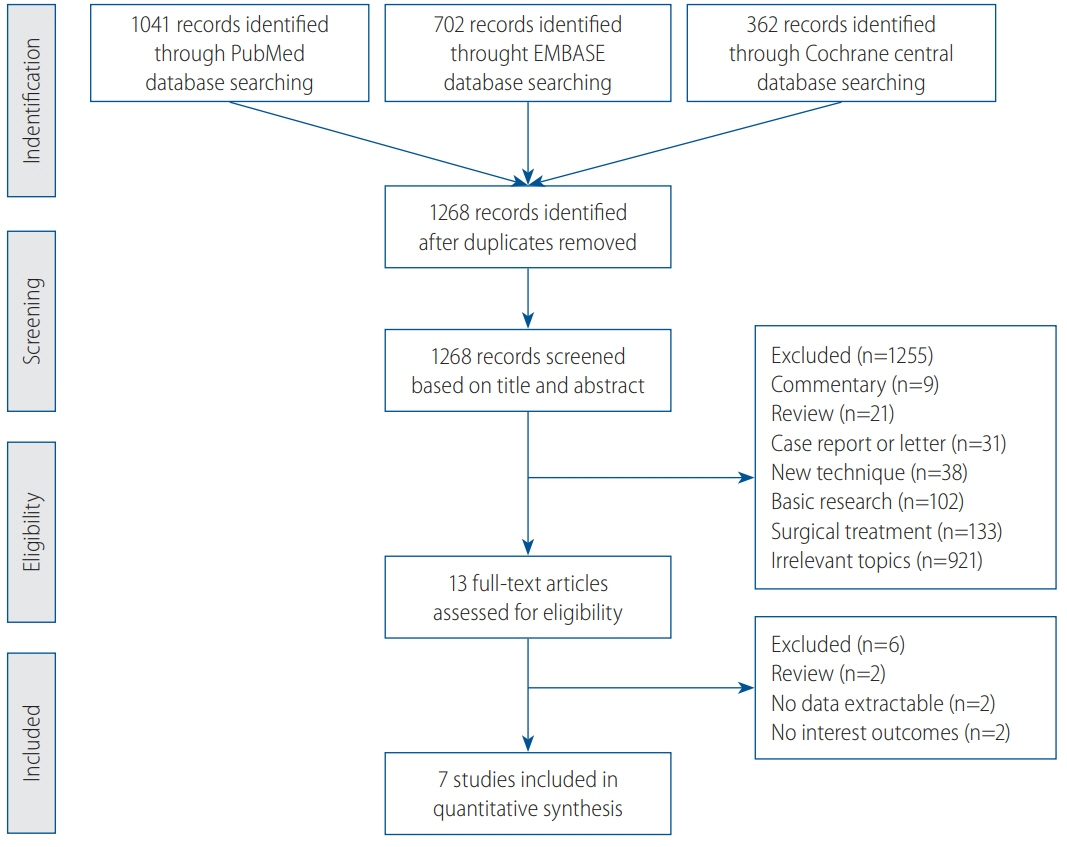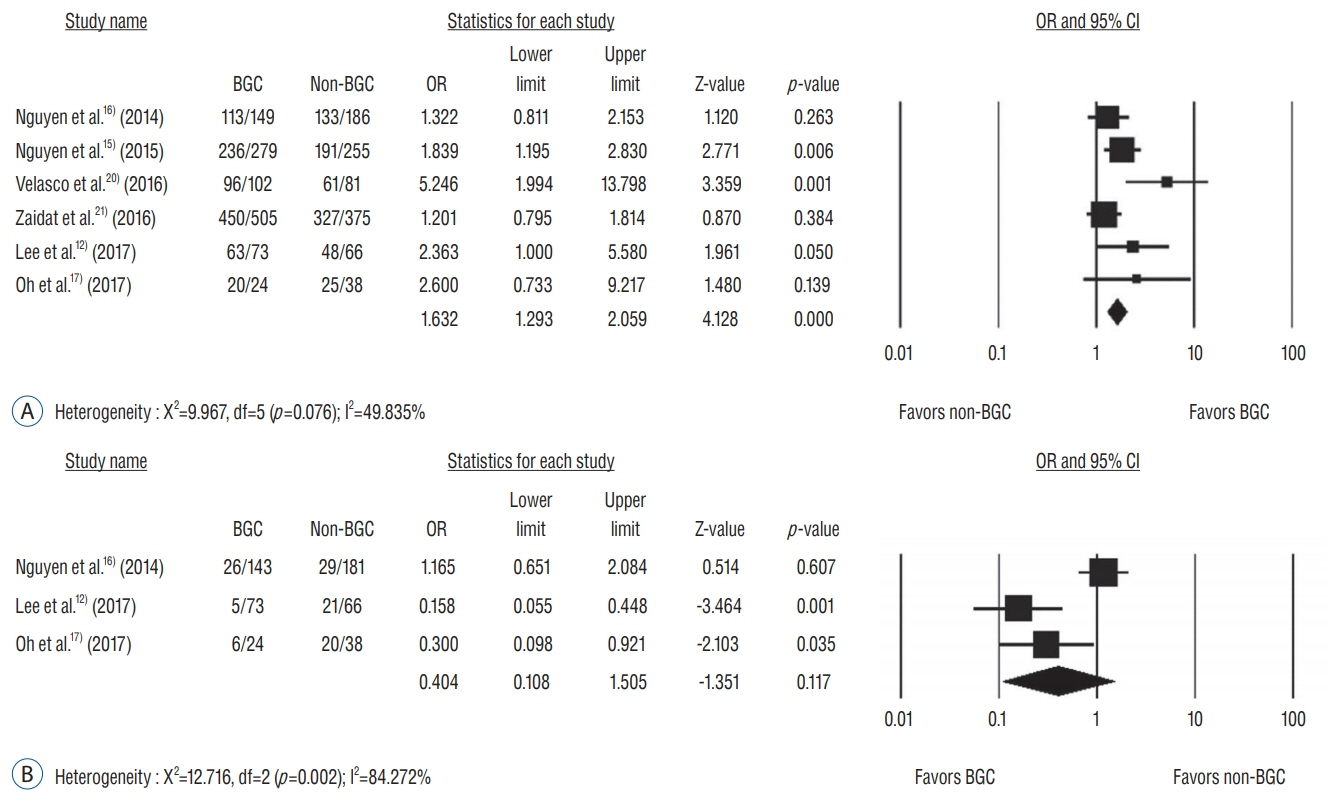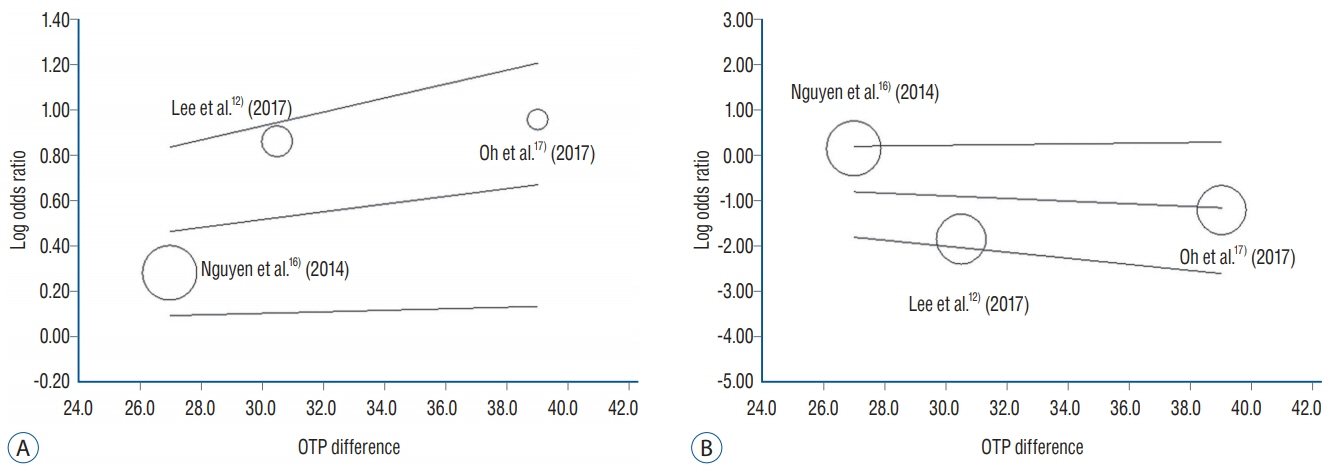J Korean Neurosurg Soc.
2019 Jul;62(4):389-397. 10.3340/jkns.2018.0165.
The Effects of Balloon-Guide Catheters on Outcomes after Mechanical Thrombectomy in Acute Ischemic Strokes: A Meta-Analysis
- Affiliations
-
- 1Department of Neurosurgery, Hallym University College of Medicine, Chuncheon, Korea. jjs6553@daum.net
- 2Perelman School of Medicine at the University of Pennsylvania, Philadelphia, PA, USA.
- 3Department of Emergency Medicine, Seoul Emergency Operations Center, Seoul, Korea.
- 4Department of Radiology, Hallym University College of Medicine, Chuncheon, Korea.
- 5Institute of New Frontier Research, Hallym University College of Medicine, Chuncheon, Korea.
- 6Genetic and Research, Hallym University College of Medicine, Chuncheon, Korea.
- KMID: 2463669
- DOI: http://doi.org/10.3340/jkns.2018.0165
Abstract
OBJECTIVE
Mechanical thrombectomies with balloon-guide catheters (BGC) are thought to improve successful recanalization rates and to decrease the incidence of distal emboli compared to thrombectomies without BGC. We aimed to assess the effects of BGC on the outcomes of mechanical thrombectomy in acute ischemic strokes.
METHODS
Studies from PubMed, EMBASE, and the Cochrane library database from January 2010 to February 2018 were reviewed. Random effect model for meta-analysis was used. Analyses such as meta-regression and the "trim-and-fill" method were additionally carried out.
RESULTS
A total of seven articles involving 2223 patients were analyzed. Mechanical thrombectomy with BGC was associated with higher rates of successful recanalization (odds ratio [OR], 1.632; 95% confidence interval [CI], 1.293-2.059). BGC did not significantly decrease distal emboli, both before (OR, 0.404; 95% CI, 0.108-1.505) and after correcting for bias (adjusted OR, 1.165; 95% CI, 0.310-4.382). Good outcomes were observed more frequently in the BGC group (OR, 1.886; 95% CI, 1.564-2.273). Symptomatic intracranial hemorrhage and mortality did not differ significantly with BGC use.
CONCLUSION
Our meta-analysis demonstrates that BGC enhance recanalization rates. However, BGC use did not decrease distal emboli after mechanical thrombectomies. This should be interpreted with caution due to possible publication bias and heterogeneity. Additional meta-analyses based on individual patient data are needed to clarify the role of BGC in mechanical thrombectomies.
Keyword
MeSH Terms
Figure
Cited by 1 articles
-
Role of Balloon Guide Catheter in Modern Endovascular Thrombectomy
Ju-Yu Chueh, Dong-Hun Kang, Byung Moon Kim, Matthew J. Gounis
J Korean Neurosurg Soc. 2020;63(1):14-25. doi: 10.3340/jkns.2019.0114.
Reference
-
References
1. Almekhlafi MA, Menon BK, Freiheit EA, Demchuk AM, Goyal M. A meta-analysis of observational intra-arterial stroke therapy studies using the merci device, penumbra system, and retrievable stents. AJNR Am J Neuroradiol. 34:140–145. 2013.
Article2. Alvarez CM, McCarthy DJ, Sur S, Snelling BM, Starke RM. Comparing mechanical thrombectomy techniques in the treatment of large vessel occlusion for acute ischemic stroke. World Neurosurg. 100:681–682. 2017.
Article3. Brinjikji W, Pasternak J, Murad MH, Cloft HJ, Welch TL, Kallmes DF, et al. Anesthesia-related outcomes for endovascular stroke revascularization: a systematic review and meta-analysis. Stroke. 48:2784–2791. 2017.
Article4. Brinjikji W, Starke RM, Murad MH, Fiorella D, Pereira VM, Goyal M, et al. Impact of balloon guide catheter on technical and clinical outcomes: a systematic review and meta-analysis. J Neurointerv Surg. 10:335–339. 2018.
Article5. Chueh JY, Kühn AL, Puri AS, Wilson SD, Wakhloo AK, Gounis MJ. Reduction in distal emboli with proximal flow control during mechanical thrombectomy: a quantitative in vitro study. Stroke. 44:1396–1401. 2013.
Article6. Goto S, Ohshima T, Ishikawa K, Yamamoto T, Shimato S, Nishizawa T, et al. A stent-retrieving into an aspiration catheter with proximal balloon (ASAP) technique: a technique of mechanical thrombectomy. World Neurosurg. 109:e468–e475. 2018.
Article7. Goyal M, Menon BK, van Zwam WH, Dippel DW, Mitchell PJ, Demchuk AM, et al. Endovascular thrombectomy after large-vessel ischaemic stroke: a meta-analysis of individual patient data from five randomised trials. Lancet. 387:1723–1731. 2016.
Article8. Jeon JP, Kim SE, Kim CH. Primary suction thrombectomy for acute ischemic stroke: a meta-analysis of the current literature. Clin Neurol Neurosurg. 163:46–52. 2017.
Article9. Kim CH, Jeon JP, Kim SE, Choi HJ, Cho YJ. Endovascular treatment with intravenous thrombolysis versus endovascular treatment alone for acute anterior circulation stroke : a meta-analysis of observational studies. J Korean Neurosurg Soc. 61:467–473. 2018.
Article10. Kurre W, Vorlaender K, Aguilar-Pérez M, Schmid E, Bäzner H, Henkes H. Frequency and relevance of anterior cerebral artery embolism caused by mechanical thrombectomy of middle cerebral artery occlusion. AJNR Am J Neuroradiol. 34:1606–1611. 2013.
Article11. Lapergue B, Blanc R, Guedin P, Decroix JP, Labreuche J, Preda C, et al. A direct aspiration, first pass technique (ADAPT) versus stent retrievers for acute stroke therapy: an observational comparative study. AJNR Am J Neuroradiol. 37:1860–1865. 2016.
Article12. Lee DH, Sung JH, Kim SU, Yi HJ, Hong JT, Lee SW. Effective use of balloon guide catheters in reducing incidence of mechanical thrombectomy related distal embolization. Acta Neurochir (Wien). 159:1671–1677. 2017.
Article13. Lee SU, Hong EP, Kim BJ, Kim SE, Jeon JP. Delayed cerebral ischemia and vasospasm after spontaneous angiogram-negative subarachnoid hemorrhage: an updated meta-analysis. World Neurosurg. 115:e558–e569. 2018.
Article14. Mokin M, Setlur Nagesh SV, Ionita CN, Mocco J, Siddiqui AH. Stent retriever thrombectomy with the cover accessory device versus proximal protection with a balloon guide catheter: in vitro stroke model comparison. J Neurointerv Surg. 8:413–417. 2016.
Article15. Nguyen TN, Castonguay AC, Nogueira RN, English J, Farid H, Veznedaroglu E, et al. Balloon guide catheter improved clinical outcomes, revascularization and decreased mortality in Trevo thrombectomy. Anaylsis of the TREVO Stent Retreiver Acute Stroke (TRACK) Registry. Florida: Society of Vascular and Interventional Neurology;2015.16. Nguyen TN, Malisch T, Castonguay AC, Gupta R, Sun CH, Martin CO, et al. Balloon guide catheter improves revascularization and clinical outcomes with the solitaire device: analysis of the North American Solitaire Acute Stroke Registry. Stroke. 45:141–145. 2014.17. Oh JS, Yoon SM, Shim JJ, Doh JW, Bae HG, Lee KS. Efficacy of balloonguiding catheter for mechanical thrombectomy in patients with anterior circulation ischemic stroke. J Korean Neurosurg Soc. 60:155–164. 2017.
Article18. Pereira V, Siddiqui A, Jovin T, Yavagal D, Levy E, Bonafé A, et al. P-016 role of balloon guiding catheter in mechanical thrombectomy using stentretrivers subgroup analysis of swift prime. J Neurointerv Surg. 7(Suppl 1):A30. 2015.19. Shah VA, Martin CO, Hawkins AM, Holloway WE, Junna S, Akhtar N. Groin complications in endovascular mechanical thrombectomy for acute ischemic stroke: a 10-year single center experience. J Neurointerv Surg. 8:568–570. 2016.
Article20. Velasco A, Buerke B, Stracke CP, Berkemeyer S, Mosimann PJ, Schwindt W, et al. Comparison of a balloon guide catheter and a non-balloon guide catheter for mechanical thrombectomy. Radiology. 280:169–176. 2016.
Article21. Zaidat O, Liebeskind D, Jahan R, Froehler M, Aziz-Sultan M, Klucznik R, et al. O-005 influence of balloon, conventional, or distal catheters on angiographic and technical outcomes in STRATIS. J Neurointerv Surg. 8(Suppl 1):A3–A4. 2016.22. Zaidat OO, Castonguay AC, Linfante I, Gupta R, Martin CO, Holloway WE, et al. First pass effect: a new measure for stroke thrombectomy devices. Stroke. 49:660–666. 2018.
- Full Text Links
- Actions
-
Cited
- CITED
-
- Close
- Share
- Similar articles
-
- Mechanical Thrombectomy in Strokes with Large-Vessel Occlusion Beyond 6 Hours: A Pooled Analysis of Randomized Trials
- Forced Arterial Suction Thrombectomy Using Distal Access Catheter in Acute Ischemic Stroke
- Successful Mechanical Thrombectomy in a 2-Year-Old Male Through a 4-French Guide Catheter
- Mechanical Thrombectomy for Large Vessel Occlusion via the Transbrachial Approach: Case Series
- Mechanical Thrombectomy for In-Hospital Onset Stroke: A Comparative Systematic Review and Meta-Analysis





